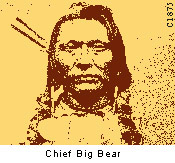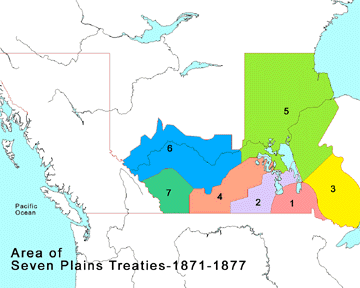


Native leaders like Poundmaker and Big Bear realized they were losing their main source of food and they were willing to negotiate with the Canadian government. But they knew they needed more than a reservation and a small cash allowance to carve out a new way of life. To establish an agricultural society they needed farm animals, wagons, horses, tools and equipment. The Treaty Commissioner promised these things, but never delivered. Time and again native leaders tried to make the government live up to its treaties. By 1879 the buffalo had disappeared from Canada. Native people were close to starvation. The government promised rations only to those who  were under treaty and there was no more room to bargain. Native people had been trying to establish reserves next to each other to create an Indian Territory, but the Canadian government forced them to break up into small bands and pushed them north, away from the best farm lands and the railway. After the Northwest Rebellion of 1885, the government, on flimsy evidence, jailed native leaders for supporting Louis Riel. In fact, the old leaders had been cautioning their people against violence because they feared a war which they would lose.
were under treaty and there was no more room to bargain. Native people had been trying to establish reserves next to each other to create an Indian Territory, but the Canadian government forced them to break up into small bands and pushed them north, away from the best farm lands and the railway. After the Northwest Rebellion of 1885, the government, on flimsy evidence, jailed native leaders for supporting Louis Riel. In fact, the old leaders had been cautioning their people against violence because they feared a war which they would lose.
Throughout the 1880s, with their leaders gone, their food source gone, their guns and horses confiscated, the native people tried to become farmers. This was supposedly the government’s policy, but this policy had a peculiar twist. It claimed that in order to “evolve” from a so-called savage to a civilized existence, native people had to go through a period of primitive peasant agriculture. This meant subsistence farming on a minimum amount of land using only the most elementary handmade tools. Labour-saving machines like seeders and binders were not allowed on the reserves.
Underlying this “peasant farming policy” was the fact that the new white settlers in the west - who happened to have economic and voting power - didn’t want competition, especially during the 1880s which were lean times for everyone. And by forcing native people onto small individual pieces of land, the tribal system would be broken and surplus land not required for subsistence would be available for European development.
Having to do everything by hand and without communal help in the short growing season of the Northwest, meant that native farmers often lost half their crops. If they did end up with a small surplus to sell, their markets were restricted. It’s not surprising that eventually they gave up. Then the government could shake its head and say that obviously native people could just not adapt to an agricultural life.
TREATIES
Between 1871 and 1877 seven treaties were signed between the Canadian government and various native tribes of the northwest ceding most of the western plains to the Canadian government (the Royal Proclamation of 1763 had stated that settlers could not occupy land that had not been surrendered to the Crown by the Indians).
The treaties were signed as follows:
Treaty No. 1 - signed August 3, 1871 with the Swampy Cree and Chippewa.
Treaty No. 2 - signed August 21, 1871 with the Chippewa.
Treaty No. 3 - signed in 1873 with the Ojibwa (or Saulteaux) and Chippewa.
Treaty No. 4 - signed on September 15, 1874 with the Cree, Ojibwa (Saulteaux), and others. (Chief Piapot argued that the written text did not contain the substance of verbal promises made during negotiations.)
Treaty No. 5 - signed September 20-24, 1875 with the Ojibwa (Saulteaux), Swampy Cree and others.
Treaty No. 6 - signed (in stages) between 1876 and 1899 with the Plains and Wood Cree. (Chiefs Poundmaker and Big Bear refused to sign the treaty.)
Treaty No. 7 - signed September 22, 1877 with the Blackfoot, Blood, Piegan, Sarcee and Stoney Indians.
In the first treaties, the Native people gave up their land in return for reservations that allowed 65 hectares of land for each family of five, a small annual payment of money and some food rations. In later treaties native people insisted on receiving farm animals and machinery so that they could support themselves with agriculture after they had given up their nomadic way of life. The government officially supported this idea of turning the natives into farmers and they sent out government agents to assist them, but in practice, government policy had the effect of making profitable farming impossible for the native peoples.
The Indian Act of 1876 governed the administration of treaties and all native matters. A separate Department of Indian Affairs was also established. The first Commissioner of Indian Affairs was Edgar Dewdney. He was followed by Hayter Reed who implemented the peasant farming policy of the 1880s.
Native people on reservations were not considered full citizens and did not have the right to vote. The government hoped that eventually they would leave the reservation and become “Canadianized.” Native children were taken from their parents and sent to boarding schools to learn English or French and the Bible

